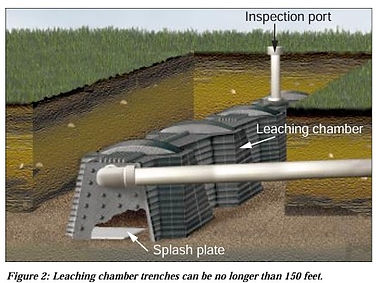
Septic System/ Wastewater Management
The purpose of a septic tank in the onsite wastewater treatment system is explicitly mentioned in the document.
The septic tank serves the following functions:
-
Separating solids from liquid wastes: The septic tank is an enclosed watertight container where solids are separated from liquid wastes that come from a home or business.
-
Initiating decomposition: Microorganisms present in the septic tank begin consuming the organic matter, solids, and nutrients in the wastewater, initiating the decomposition process.
-
Preparing liquid effluent for further treatment: After solids are separated and decomposition starts in the septic tank, the liquid effluent moves on to the soil absorption field for further treatment before being released into the soil.
SEPTIC TANKS
Conventional Septic System

A conventional septic system is a wastewater treatment system that collects and treats wastewater from a building and then disperses it into a drain field. The system has two main parts: a septic tank and a leach field.
Here's how a conventional septic system works:
-
Anaerobic bacteria in the tank break down the liquid and solid waste.
-
The wastewater is then pushed out of the tank and sent through treatment tanks.
-
The treated wastewater, or effluent, is then released into the drain field.
-
Bacteria in the drain field break down the wastewater pollutants.
-
The treated effluent returns to the property's soil and groundwater.
-
Wastewater from toilets and drains flows into the septic tank.
-
Solids sink to the bottom of the tank, while liquids rise to the top and form a layer of scum.
Conventional septic systems are often used in areas with shallow soils or high water tables. Some benefits of conventional septic systems include: Low maintenance, Low cost of operation, No electricity needed, and Can be used in a variety of soil types.
Aerobic Septic System

-
Aerobic treatment units remove 85 to 98 percent of organic matter and solids from wastewater, producing effluent as clean as municipal wastewater treatment plants.
-
Regular maintenance of aerobic treatment unit components is crucial for optimal performance, including monitoring the trash tank, checking the air pump, maintaining electricity supply, and ensuring proper functioning of spray heads.
-
Proper sizing of aerobic treatment units based on daily wastewater flow from the residence is essential to ensure effective treatment.
-
The aerobic treatment process involves components like a pretreatment tank, aeration chamber, settling chamber, and final treatment and dispersal component, all working together to purify wastewater.
-
To keep the aerobic treatment unit working effectively, it is important to follow manufacturer's recommendations for maintenance, monitor system components, maintain a landscape cover in the spray field, and address any alarms promptly to prevent issues.
DRAINFIELDS
GRAVELESS PIPE

-
Gravel-less pipe systems distribute treated wastewater into the soil using corrugated, perforated polyethylene pipes wrapped in geotextile fabric.
-
The gravel-less pipe system includes a treatment device (usually a septic tank), gravel-less pipe, and pipe trenches that are 2 feet wide and up to 150 feet long.
-
The gravel-less pipe must be placed in a trench with specific dimensions based on the pipe diameter, and multiple trenches can be connected with a solid 4-inch-diameter pipe.
-
Advantages of gravel-less pipes include lightweight material, flexibility for curved trenches, and the requirement of only a septic tank for pretreatment.
-
Disadvantages of gravel-less pipe systems include the need for well-aerated soil, a 2-foot separation distance from restrictive horizons or groundwater, and the potential for geotextile fabric clogging if not properly aerated.
GRAVEL PIPE

-
The septic tank and soil absorption system is a cost-efficient method for treating residential wastewater, but it requires proper sizing, construction, and maintenance to function effectively.
-
The septic tank separates solids from wastewater, with up to 50% of the solids decomposing and the rest accumulating as sludge that needs periodic removal.
-
The septic tank should be watertight to prevent rainwater from entering the system and saturating the soil absorption field.
-
The soil absorption field provides final treatment by relying on soil microorganisms to remove organic matter, solids, and nutrients from the wastewater.
-
Regular maintenance tasks include pumping the septic tank every few years based on household size, wastewater flow, and solids content, as well as cleaning the effluent filter and protecting the soil absorption field from solids and rainfall.
LEACHING CHAMBER
-
Leaching chamber systems handle wastewater similarly to conventional gravel-filled trench systems, with the main difference being in how the trench is constructed.
-
A leaching chamber system consists of a treatment device (usually a septic tank), a leaching chamber made of plastic, and leaching chamber trenches that should not exceed 150 feet in length.
-
Advantages of leaching chambers include their lightweight material, smaller drain field requirements (up to 40% smaller for houses without water-saving devices and 20% smaller for houses with such devices), and the absence of the need for additional perforated pipe or geotextile fabric.
-
Disadvantages include restrictions on reducing drain field size in certain soil classes and the requirement to keep the bottom of the chamber at least 2 feet above a restrictive horizon or groundwater.
-
Proper maintenance of leaching chambers involves following the manufacturer's recommendations, regular pump-outs every 2 to 3 years, maintaining a grass cover over the trenches, avoiding placing solid materials over the ground surface, conserving water to prevent flooding, and refraining from driving heavy equipment across the drain field.

DRIP IRRIGATION

A drip system is a particular type of aerobic system which functions primarily underground. These systems are highly effective and work by moving the wastewater slowly through “drips”. These drips move the wastewater consistently through the system and redistribute it into the grass. The system has 3 main components; the septic tank, the lift tank which contains the pump and filter, and the dispersal unit. The septic tank is the same as usual – the place where the waste collects from your home and is broken down. The lift tank contains the pump and filter for the system. This helps distribute the water through the soil and pipes. The dispersal unit consists of a supply and return line. The system is actually quite complex and requires a high level of expertise to maintain.
SURFACE IRRIGATION/ SPINKLER SYSTEM
Surface irrigation and sprinklers can be used in aerobic septic systems to treat wastewater and dispose of it on a lawn, which can then be used for irrigation. This process is called a "spray field" and can save money on utility bills.
Here are some things to know about surface irrigation and sprinklers in septic systems:
-
Water treatment
Septic systems treat wastewater to remove organic solids and prepare it for secondary treatment.
-
Sprinkler heads
Two or more sprinkler heads distribute water onto the lawn, and are activated by a system timer and mechanical floats.
-
Water reuse
The water used in sprinkler systems is treated wastewater that is safe to spray on the lawn for irrigation.
-
Non-potable water
Sprinkler systems that use reused water that is not fit to drink are often marked with the color purple.
-
System size
Some systems may not be large enough to irrigate an entire lawn or garden.

OPERATION & MAINTENANCE
-
Onsite wastewater treatment systems are now considered a permanent solution for treating wastewater, and it is vital to maintain them regularly to prevent pollution and health hazards.
-
Different factors affect the operation and maintenance of onsite wastewater treatment systems, including the treatment method used, the volume of wastewater, and the strength of the wastewater.
-
Maintenance of onsite wastewater treatment systems is crucial to prevent malfunctions, and specific tips are provided, such as regular cleaning of the septic tank, avoiding excessive water use, and not flushing inappropriate items down the drain.
-
Water conservation practices can significantly reduce the amount of water entering the onsite wastewater treatment system, including taking showers instead of baths, repairing leaks promptly, and using water-saving fixtures.
-
It is essential to understand that an onsite wastewater treatment system is not the same as a centralized sewer system, and individual water-use habits directly impact the system's effectiveness.
CAUSES OF MALFUNCTION
Causes of malfunction in an onsite wastewater treatment system as explicitly mentioned in the document include:
-
Overloading the system with water by using more water than average for the size of the house.
-
Having stronger than average wastewater due to activities like using a garbage disposal or operating high-strength businesses at home.
-
Inadequate treatment of wastewater by the soil, especially in problem soils like fractured rock, Karst limestone, or gravelly sand.
-
Building structures over the treatment works or soil treatment area, hindering maintenance access and water evaporation.
-
Driving heavy equipment over system components, potentially damaging them.
-
Adding unnecessary chemical additives that can harm the system's operation.
-
Allowing interruptions in electrical service to systems with mechanical components or alarms.
-
Overloading the system with excessive wastewater flows, such as from washing all clothes in one day.
-
Sending back-flush water from water softeners into the system, which can overload it.
-
Not following maintenance guidelines, like infrequent septic tank cleaning or neglecting to divert rainwater away from the soil treatment area.
WATER CONSERVATION
Water conservation tips explicitly mentioned in the document include:
-
Taking showers instead of baths and installing water-saving shower heads.
-
Repairing leaky faucets and faulty toilet-filling mechanisms promptly.
-
Checking toilets for leaks using food coloring or leak detection tablets.
-
Installing water-efficient toilets or using toilet tank dams to reduce water usage.
-
Operating the dishwasher with a full load whenever possible.
-
Avoiding continuous running water when brushing teeth, washing hands, or cleaning vegetables.
-
Using faucet aerators to restrict water flow.
-
Keeping a container of drinking water in the refrigerator instead of running the faucet until the water turns cool.
-
Insulating hot-water pipes to avoid wasting water while waiting for heated water.
-
Inquiring about water conservation programs from local authorities to learn about water-saving initiatives.